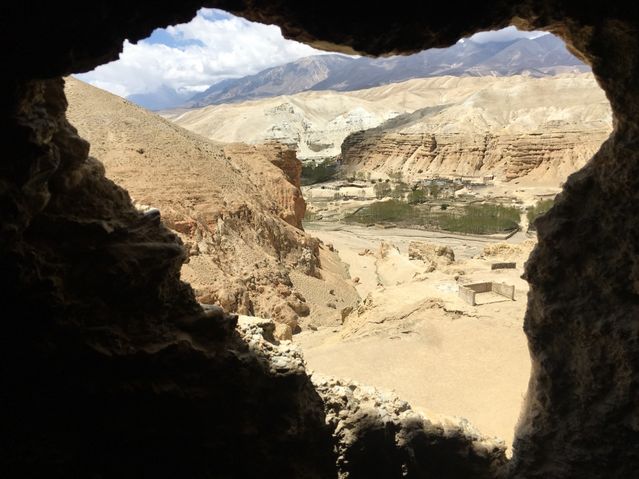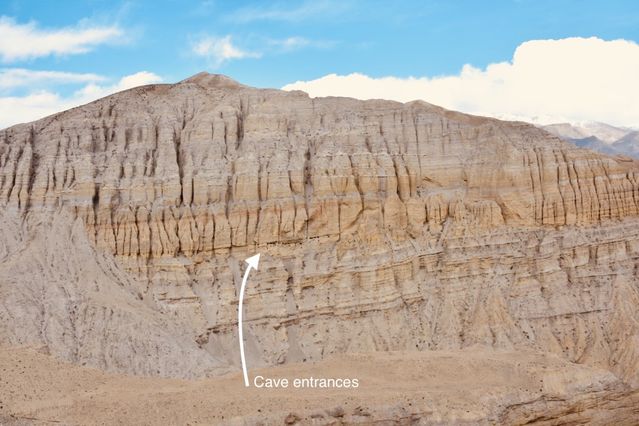
Fear
Turning the Wheel from Fear to Openness
What if the fear you carry is really just ancient history?
Posted May 22, 2018
Peering from the Sky Cave window down to the valley floor 40 meters below, one can see many kilometers down the valley. Inside this rock cave, five-stories high and 40-rooms deep in Upper Mustang Nepal, our eyes trace the dusty alpine desert and the stony river. Deep in this rock cave life could only have been harsh for there is no water, constant dirt, and tiny cramped rooms. Small groups of humans lived here seeking safety from intruders, crusaders, and war-makers. The fearfulness of the original inhabitants is obvious.

There are an estimated 10,000 caves here in Mustang (pronounced Moos-Tung). We are traveling on a Mindful Adventure, taking a group of health professionals to learn about mindfulness in contexts where it has evolved over millennia. As we walk up the Kali Ghandaki river valley the cave windows stare down at us from cliff faces at dizzying heights up to 50 vertical meters above. We are on the Nepal side of the Tibetan plateau with the Tibetan border visible. There are no trees here to build ladders so we speculate how the caves were accessed. Rope perhaps? Mystery surrounds them. Some were burial chambers found with skeletons 3000 years old, some hid ancient monasteries during religious wars, some were meditation caves (and still are), others were wartime hideouts. An occasional cave window still shows window ledges piled high with stones, ready weapons to hurl at any approaching enemy.
This cave we are in was a home. Why did humans go to such effort to live in interconnected caves in the sky? Gazing down the valley, it seems that escaping other humans was a primary motive. There must have been easier ways to find shelter and safety from wild animals than scrambling up a 50-meter vertical cliff.
Deep inside this cave ancient human history reaches into modernity, and we speculate that humans have transmitted this fear across generations. Our human heritage is palpable when crawling through the dirt floors. Thousands of cooking fires have left their mark in creosote caked ceilings. Tiny rooms just a few meters wide housed one family each. Inside the biggest meeting cave, it is like stepping into Plato’s cave allegory with dark creosote walls and shadows playing. Whoever lived here feared "others" constantly. Just leaving the caves to collect water was a significant risk. We are told of a woman who tricked the enemy by washing her hair in oil and allowing it to hang dripping out of the window of the cave; the story goes that if the enemy saw her wet hair they would think the tribe had water and would never leave their cave.

Mustang caves confront us with the evolution of our anxiety. Even though we are a cooperative social species our fear of others has been long held. Through multiple processes of evolution—genetic, epigenetic, behavioral, and symbolic— we have learned both fear and cooperation.
These caves also give me pause over our modern fears. We know transmission of trauma and anxiety happens across generations. Do we really need to continue this fear of our neighbor today? Many modern humans have the security of homes with locked doors, nearby police, and state laws (sadly not all humans do). Do those who live in relative safety need the old fears of ‘other’ in today’s modern world? How can we loosen fear’s grip?
Key evolutionists argue that our evolutionary heritage does not need to determine us. If we take a perspective that our history of fear is driving us to be afraid of each other, we can change direction. Fear is essential, but so is opening up to compassion and kindness for others. Now is the time to understand how thousands of years of fear in our heritage might be influencing us in ways we no longer want. We can be hopeful. Preliminary research suggests there are precise genetic mechanisms that turn the inheritance of environmental influences "on" and "off”. If this can be shown in humans it will give us evidence to disregard the notion that we only change through passive decay of heritable traits.
What if it only took a short time to learn to open up to others? What if we helped young people today by changing our fear cycles and began practicing openness, kindness, and compassion in schools. What if we adults modeled it to them? Could it become a well-learned repertoire for humans? In our book, The Thriving Adolescent, we have an exercise called “The Walk of Life” where we do just this, we help kids see the walks they have taken before, and then practice new ways of stepping into a more flexible journey. One example is acceptance and commitment training, delivered to groups to normalize and help adults with fear and anxiety of others. It's never too late.
We are the co-operative species. We are also the species that destroy each other through psychologically derived fear. Are we smart enough to dial up compassion and kindness to others instead?
References
Biglan, A, S. C. Hayes, & D. S. Wilson. (2015). The nurture effect. Oakland CA: New Harbinger
Biglan, A, S. C. Hayes, & D. S. Wilson. (2015). The nurture effect. New Harbinger. Oakland CA
Darnal, P. (2017). Significant Heritages of Upper Mustang and Issue of Conservation. Dhaulagiri Journal of Sociology and Anthropology, [S.l.], v. 11, p. 1-23, dec. 2017. ISSN 1994-2672. doi:http://dx.doi.org/10.3126/dsaj.v11i0.18820.
Jablonka, E., Lamb, M. J., & Zeligowski, A. (2014). Evolution in four dimensions : genetic, epigenetic, behavioral, and symbolic variation in the history of life. Cambridge, Massachusetts ; London, England : A Bradford Book, The MIT Press.
Wilson, E. O. (2013). The social conquest of earth. New York: Liveright/Norton Publishing
Yehuda, R., Daskalakis, N. P., Bierer, L. M., Bader, H. N., Klengel, T., Holsboer, F., & Binder, E. B. (2016). Holocaust Exposure Induced Intergenerational Effects on FKBP5 Methylation. Biological Psychiatry, 80(5), 372-380. doi:10.1016/j.biopsych.2015.08.005

